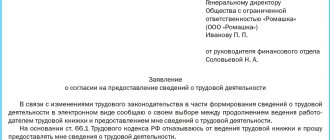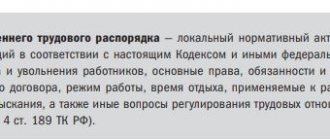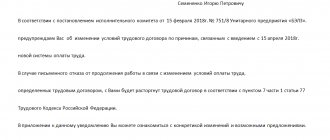What are the Rules for?
This regulatory document establishes:
- procedure for hiring and dismissing employees,
- work and rest schedule at the enterprise,
- conditions for the provision of bonuses, benefits, financial assistance,
- procedure for sending employees on vacations, business trips,
- obligations and rights of the parties, etc.
The document is written based on the needs and capabilities of the organization, taking into account the regulatory legal framework based on articles of the Labor Code of the Russian Federation and state standards and can contain any number of points.
The main objective of the Rules: to promote the competent distribution and use of working time, strengthen labor discipline, increase the efficiency of the production process, etc.
It should be noted that not all enterprises in the commercial sector use the Rules in their personnel records, which today is not a violation of the law. There is only one important condition: the relationship between the employer and subordinates must fit within the framework of the current legislation.
Articles on the topic (click to view)
- What is taken into account when imposing a disciplinary sanction
- How long does it take for a disciplinary sanction to be lifted?
- What are the consequences of disciplinary action at work?
- How long is the duration of a disciplinary sanction?
- Minutes of the general meeting of the labor collective: sample 2020
- Order to lift a disciplinary sanction: sample 2020
- Order on violation of official duties: sample 2020
But state budgetary institutions are required to use these Rules in their work, and their drafting is regulated to the smallest detail.
The internal regulations apply to all personnel of the organization, regardless of the position of a particular employee, so everyone must be familiarized with them upon signature.
Expert opinion
Polyakov Pyotr Borisovich
Lawyer with 6 years of experience. Specialization: civil law. More than 3 years of experience in drafting contracts.
The drafting of the Rules must be treated with extreme care, since in some cases they can become evidence in court when resolving labor conflicts and disagreements, both on the part of the employer and the subordinate.
In order to put the Rules into effect, the enterprise must issue an order on behalf of the manager. Moreover, if the company has a trade union organization, its representatives must be familiar with the Rules even before their approval.
Labor regulations of the organization
Internal labor regulations are necessary for both employees and employers.
Most employers independently develop this document and can indicate all the necessary aspects in it. Such freedom is not available to government agencies; their internal labor regulations are subject to strict regulations. The internal labor regulations of commercial firms and individual entrepreneurs are created on the basis of labor legislation, taking into account internal specifics. At the same time, the fundamental term of this local act is labor regulations, which is directly related to the definition of labor discipline: it is obligatory for all employees to obey internal rules of behavior.
IMPORTANT! The definition of internal labor regulations is given in Art. 189 of the Labor Code of the Russian Federation: a local regulatory act containing the basic rights and obligations of the parties to an employment contract, work and rest hours, penalties and incentives and other issues of regulating labor relations.
More details about the concepts given in Art. 189 of the Labor Code of the Russian Federation, read the material “Art. 189 of the Labor Code of the Russian Federation: questions and answers.”
Based on this definition, internal labor regulations can be formalized in a separate local act, which all employees are familiar with upon signature. However, it will not be considered a violation, for example, to include the regulations in the form of a separate section or annex to the collective agreement (Article 190 of the Labor Code of the Russian Federation).
If the employer does not have special requirements for employees, and all VTR rules are reflected in employment contracts, bonus regulations or internal instructions, the employer can limit itself only to these documents and refuse to draw up separate internal labor regulations.
Internal labor regulations are a mandatory local regulatory act of an organization, which contains all the information about how the work of the workforce is organized and on what principles relationships with employees are based. Such a personnel document should regulate the procedure for hiring and dismissal, drawing up a vacation schedule, remuneration, bonuses and punishment for misconduct - all the main aspects of the life of the organization.
ConsultantPlus TRY FREE
Get access
Each organization, in accordance with legal requirements, must have several internal regulations that regulate the general order in one direction.
If in accounting this is an accounting policy, then in human resources these are internal labor regulations. All employers must have this document, regardless of their form and status (yes, individual entrepreneurs are also needed), according to Article 189 of the Labor Code of the Russian Federation.
Since many issues are regulated by such rules, actually covering the entire cycle of the organization’s working life, the rules always have many pages and sections.
The employer will have to draw it up independently, preferably at the very beginning of the activity, because the internal labor regulations of the organization (sample 2020), which we will consider below, are approved before hiring the first employees.
Legislators took care of employers and developed a sample of the internal regulations of an enterprise, which was approved by Decree of the USSR State Committee for Labor of July 20, 1984 No. 213, that is, back in the Soviet Union and more than 30 years ago. It is obvious that it is almost impossible to use these rules in modern conditions.
Theoretically, they can be taken as a basis, because if legal requirements have changed significantly, then the general principles of approach to this issue do not depend on time.
Internal labor regulations must be agreed upon with the trade union committee and this agreement is documented in a protocol and placed on the title page of the local regulatory act. In addition, this important document must be approved by the head of the organization or individual entrepreneur personally.
In fact, the internal regulatory act of a single company in this case should duplicate in miniature the large Labor Code of the entire country. Labor regulations should include the following sections, which closely overlap with the articles of the Labor Code:
- procedure for hiring employees;
- procedure for dismissing employees;
- work schedule and rest time;
- basic rights and obligations of the employer;
- basic rights and responsibilities of employees;
- employer's liability;
- employee responsibility;
- remuneration procedure;
- incentives and penalties;
- other issues of regulation of labor relations (you can specify in the document requirements for the appearance of employees, the so-called dress code, as well as restrictions on the use of personal phones during work hours, etc.).
If the employer accidentally forgets and does not include in the labor regulations, a sample of which we will consider below, any important section that regulates the corresponding section in the Labor Code, then when checked by the State Labor Inspectorate, this fact will lead to the issuance of an order, since this is a violation.
Therefore, when forming a document, you cannot omit any of the fundamental articles of the Labor Code; however, it is also not worth rewriting half of the code verbatim into these rules. It is important to remember the main thing: none of the requirements of the company’s internal labor regulations can worsen the situation of workers, in comparison with the standards established by Russian labor legislation. In this case, Article 8 of the Labor Code of the Russian Federation works, which simply cancels such requirements.
Before moving on to drawing up the rules, it is necessary to remember what does not need to be included in the internal labor regulations of the organization (the 2020 sample can be seen below).
First of all, this local act must contain the general working conditions in a particular company and the general requirements of its management for employees, since Article 21 of the Labor Code of the Russian Federation directly stipulates that every employed citizen is obliged to comply with the discipline and internal labor regulations of the enterprise where he works .
Therefore, the rules should be of a general nature, applicable to absolutely every employee: from the cleaner to the heads of departments. There should not be any personal requirements in it. This means that all job responsibilities, requirements for workplaces and the characteristics of the functioning of individuals must be spelled out in other documents, which, in particular, include employment contracts, job descriptions and other agreements. There is no place for such requirements in the general rules.
First, you should get approval from the trade union (if you have one), since its participation in this matter is mandatory. And then indicate the details of the minutes of the trade union meeting.
Labor regulations should be approved by a separate order for the organization.
All already working employees must be familiarized with the new document against signature: to record familiarization, you can use a special register or familiarization log.
We invite you to familiarize yourself with: Sample letter on application of UTII for a counterparty
It is also important in the future to issue rules for careful study by new employees when they are hired. They must also confirm that they have read and understood the document by signing the review log.
Article 68 of the Labor Code of the Russian Federation regulates this before concluding an employment contract and issuing an order for employment.
As mentioned above, this is a very voluminous document that must take into account the requirements of labor legislation. Some of its points may cover general rules, while others may be more specific.
Let's look in more detail at what this act should look like and what should not be forgotten in each of its sections.
The title page must contain the full name of the organization and its abbreviated version; it must contain the manager’s visa confirming the approval of the document with a date. This procedure is determined by Article 190 of the Labor Code of the Russian Federation.
Next come the remaining sections, which the compiler can arrange in any order. In each of them, you can take into account the specific nuances of the organization’s work.
Disciplinary action
The Internal Labor Regulations can include a complete list of violations of discipline in the workplace, which, according to the provisions of Article 81 of the Labor Code of the Russian Federation, can lead to dismissal (absenteeism, drunkenness during working hours, hooliganism, etc.).
You can even specify norms that are not disclosed in the code, for example, indicate which offenses will lead to the dismissal of employees holding certain positions. One can cite as an argument the position of the Supreme Court, set out in paragraph 49 of the Resolution of the Plenum of the RF Armed Forces of March 17.
2004 No. 2, where the judge cited his failure to fulfill his duties as a gross violation on the part of the manager, which resulted in harm to the health of workers or property damage to the company.
Work time
For employees with normal working hours, the following working hours are established:
- a five-day work week with two days off - Saturday and Sunday;
- The duration of daily work is 8 hours;
- work start time - 9.00, work end time - 18.00;
- break for rest and food lasting one hour from 13.00 to 14.00. This break is not included in working hours and is not paid.
In the same section, all weekends and holidays must be listed in accordance with the production calendar, which is approved by the Government. If a company operates on a special schedule within the framework of the Labor Code, this must also be described in detail in this section.
https://youtu.be/fZ4OOiXmlEE
Direct order issuer
An order to approve the Rules can be written by any employee of the organization whose job responsibilities include this function or by an employee authorized to formulate orders by a separate order of the manager. It could be:
- legal adviser,
- head or HR specialist,
- secretary, etc.
After drawing up the form, it should be given to the director of the organization for approval - without his signature it will not be considered valid and it can be easily challenged through a court or labor inspectorate.
An order for approval of the Internal Labor Regulations must be drawn up both during the initial formation of the document and in cases where any changes have been made to the Rules or they have been completely “reformatted”.
This is important to know: Order on the labor dispute commission: sample 2020
Order on the creation of internal labor regulations sample
You may also be interested in the following approval order forms:
- Salary provisions - ;
- Labor safety instructions - ;
- job descriptions - .
An example of such an order is provided for free download below. The form must contain the following details:
- the reason for the order;
- word - Order;
- city where the company is located;
- title - about the approval of the Internal Labor Regulations;
- word - I ORDER;
- an order to approve and put into effect a document called the Internal Labor Regulations - attach it to the approval order form;
- ordering employees to follow the provisions of these rules;
- the order of the head of the personnel department to convey to each employee the contents of the Rules against signature - an introductory sheet with the signatures of the employees should be attached to the approval order;
- details of the organization (should be entered manually or use the organization’s letterhead);
Order on approval of internal labor regulations sample
Currently, many organizations in order to retain and. Approve internal labor regulations, name of organization, details. LLC Enterprise, approved by order.
Hiring is formalized by order of the General Director.
https://youtu.be/vG6BEE4El3Y
On approval of the Rules. Order on approval of internal labor regulations, sample download in W format. Internal labor regulations, sample, order, form.
Order on approval of internal rules
We approve internal labor regulations using an order
A mandatory condition that must be observed when drawing up an order is the presence of signatures of the persons mentioned in it.
When hiring a new employee, the person in charge provides him with labor regulations to study; Full name and position of the employee who will monitor the execution of the order; Appendix – developed labor regulations at the enterprise, subject to approval; Full name and signature of the company director; signatures of responsible persons.
Order on approval of internal labor regulations for 2020
Inspection bodies will take into account that in such organizations the rules are drawn up taking into account all the nuances.
The employee's position does not affect the dissemination of internal regulations. To agree with the order, each employee must sign.
The management of the enterprise must be attentive to the rules drawn up, since all conflict situations will be resolved taking into account the points from the order. Because of this, the document can become an advantage not only for the employer, but also for the employee.
Articles Any employee who is listed at the headquarters of the organization can draw up rules and his responsibilities include the formation of orders.
These workers may include:
- secretary;
- HR employee;
- legal adviser and others.
After the rules are formed, the document must be submitted to the director of the organization, who must confirm the validity of the order with his signature.
Order on amendments to the Internal Labor Regulations
This document helps to establish discipline in the organization, is important for increasing labor productivity, increasing the quantity and quality of products and, in general, in a more global sense, it contributes to the development of the enterprise and the expansion of prospects.
Each person, when applying for a job in a company that applies the Internal Labor Regulations, must be familiarized with them against signature.
This equally applies to those who work part-time, are on a business trip, or are undergoing training at an organization. The document is usually formed at the very beginning of the company's activities. It is prepared by the management of the organization together with the legal service and issued.
However, in the process of development of an enterprise, working conditions may arise that are not regulated by the Rules; in addition, some important changes may occur in the Legislation.
Source: https://advokatssr.ru/prikaz-o-sozdanii-pravil-vnutrennego-trudovogo-rasporjadka-obrazec-12148/
Rationale and basis for creating an order
Like any other administrative document, this order must have some basis, i.e. justification and basis.
The substantiating point in this case is the reason for creating the order, i.e. the need of the company that the document solves (for example, to organize the activities of the work team, prevent labor conflicts and disputes, etc.).
As a basis , you can refer to the clause of the law of the Russian Federation, which regulates the creation of internal labor regulations.
What information should not be included in labor regulations?
In addition to the basic information that must be contained in the internal labor regulations, the employer also needs to be aware of some information that is not included in this document. First of all, this includes individual personal information that may concern only one employee.
As you know, internal labor regulations are a general document that applies to absolutely all employees working in a given organization. Therefore, this document should include general information only, without any specifications or individual requirements.
If a manager, for example, needs to establish some individual requirements for specific positions, he can use employment contracts for this. It is in them that more accurate information regarding a specific employee can be included. If an employment contract has already been concluded with this employee, the optimal solution in this case would be to create an additional agreement to it. It is in it that it will be possible to place all the required information that will be directly related to the work of a particular employee.
Nuances of document preparation
The order does not have a single unified model approved at the legislative level. So enterprises and organizations can write it in free form or according to a template approved within the company. In this case, there is a number of information that must be indicated in the document:
- number, date,
- place of compilation,
- full company name,
- basis for formation.
The order also needs to give a specific instruction, usually drawn up in the form of separate paragraphs. In this part, you should definitely include the number and date of preparation of the approved Internal Labor Regulations, as well as the date of their entry into force. All other information is prescribed based on the needs of the enterprise.
It is necessary to note the employees responsible for its implementation (these issues are usually controlled by the personnel officer), and as an appendix, indicate the rules themselves and, if necessary, other attached documents.
Document retention periods
It is legally established that internal labor regulations must be stored in accordance with the List of standard management archival documents for one year from the moment they lose their force. It is recommended to store together with this local act and the order for its entry into force.
In most cases, a local act is an annex to the order by which it is put into effect. In this regard, the order approving the internal regulations must be kept for the entire period of validity of the Rules, as well as for another year if they are declared to have lost their validity as a result of the entry into force of new regulations.
What to pay attention to when placing an order
There are no special requirements for the execution of the order, as well as for its content: it can be written by hand (with a ballpoint pen of any color, but not with a pencil) or printed on a computer. To create a document, both the organization’s letterhead and a simple blank sheet of paper are suitable.
Expert opinion
Polyakov Pyotr Borisovich
Lawyer with 6 years of experience. Specialization: civil law. More than 3 years of experience in drafting contracts.
Only one condition must be observed: the order must be signed by the head of the company or his representative and the employees responsible for its implementation.
Today, it is not necessary to certify a form using a seal or stamp, since the use of stamp products is no longer a norm prescribed by law, even for legal entities (the exception is those organizations in which the obligation to use seals and stamps is approved in internal regulations).
Procedure for applying the order
Internal labor regulations are a regulatory act of an organization in which it determines what time employees should work and what periods are rest time.
In addition, in this document the company can consider other issues that arise between the administration and its hired personnel when carrying out activities.
Specialists from various professions may be involved in the development of these Rules. Moreover, when accepting the final version, it is desirable that each of them put their visa on the document as approval.
This is important to know: Military discipline, rewards and disciplinary sanctions
Once a draft local regulation has been created, it must be put into effect accordingly. As a rule, an order approving internal labor regulations is used for this purpose.
Before approval, the created regulatory document must also be sent for approval to the trade union bodies of the business entity, if they exist.
It must be remembered that this regulatory act of a company can be either an independent document, or it can be used as an annex to the main local act, for example, to a Collective Agreement. In the latter case, there is no need to issue an order approving internal regulations.
Most often, such a duty to compile is assigned to the organization’s personnel service or office management department. They prepare a draft order, and the responsible official signs it.
Such a procedure can only be carried out by persons authorized to do so by the charter, for example, a director. It is necessary to take into account that the introduced internal regulations come as an annex to the order by which they are put into effect.
After the order is issued, the entry “Approved” is marked with a special stamp on the Rules, and the details of the issued order to enter this document are indicated.
Basic rules of VTR
When developing internal labor regulations, it is necessary to proceed from those listed in Art. 189 of the Labor Code of the Russian Federation important components for it, without forgetting about corporate nuances. Each employer decides for himself in what volume and composition this document will be drawn up.
Approximate content of internal labor regulations:
- general provisions (purpose of rules, development goals, scope of distribution and other organizational issues);
- hiring and dismissal of employees;
- rights and obligations of the employer and employees;
- work and rest time;
- labor discipline (discipline and encouragement of employees);
- final provisions.
The first (general) organizational section, in addition to what is listed, may include terms and definitions used in these rules.
The description of the procedures associated with the admission, transfer or dismissal of employees can be supplemented by a list of documents required from the employee upon admission to work and issued by the company itself during the employee’s labor activity.
To find out what these documents might be, read the article “How is hiring an employee formalized?”
IMPORTANT! Art. is devoted to employment issues. 68 of the Labor Code of the Russian Federation, and the dismissal process requires compliance with the requirements of Art. 77–84.1, 179–180 and other articles of the Labor Code of the Russian Federation.
We invite you to read: For what period is compensation paid for leave upon dismissal - Labor assistance
When developing rules regarding the rights and obligations of the employer and employees, not only a formal listing is required, but also verification of their compliance with the requirements of labor legislation (Articles 21, 22 of the Labor Code of the Russian Federation).
Infringing on the rights of employees, as well as imposing unnecessary responsibilities on them by the employer, is unacceptable. In this regard, a trade union committee or other body guarding the observance of the legitimate interests of workers can have a significant influence on the content and composition of the VTR rules.
order approving PVTR
Let's look at an example of how you can draw up an order approving internal labor regulations.
The law does not establish a special form for it, so companies can draw it up in any form using company letterhead.
Otherwise, the preparation of the document must begin by recording the full name of the company, its address and details. Next, you need to indicate the name of the document and its serial number. In the future, the form will need to be registered under it in a special order book.
Below on one line at different ends of the sheet you need to write down the place and date of compilation.
Then, on a new line in the middle, the full name of the order is indicated.
Next from a new line comes the introductory part of the order. It is necessary to justify why it was decided to introduce these rules. This could be, for example, “For the purpose of regulating issues of organizing working conditions, and maintaining discipline at work and in production.”
Expert opinion
Polyakov Pyotr Borisovich
Lawyer with 6 years of experience. Specialization: civil law. More than 3 years of experience in drafting contracts.
In the same part of the order, one can mention the provisions of the Labor Code of the Russian Federation, which regulate the correct execution of these actions. After this, the word “I order” is indicated on a new line.
Next, the manager’s orders are indicated point by point:
- Approval of the drawn up rules and indicate the date from which they should take effect;
- If the enterprise already had rules, and a new version of them is being put into effect, then the old rules must be declared invalid from the date the new ones are introduced;
- Indicate that employees must be guided by them when performing daily duties;
- Determine the official who will be responsible for familiarizing all company employees with the new rules. This must be done under signature;
- It can also be separately established that it is necessary to familiarize all employees hired at the enterprise with the rules, and also determine who will do this;
- Identify a person who will monitor the execution of this order.
As an appendix to the order, you need to write down the details of the draft rules, as well as the number of pages it occupies.
A fully completed order approving internal labor regulations must be signed by the head of the company. Be sure to write down his position and personal data next to the signature.
This is important to know: Disciplinary sanctions in the state civil service
If the order appointed responsible employees, then at the bottom of the order it is necessary to provide columns on which they could put their signatures, transcripts and dates of familiarization.
Why are house rules needed?
Their functions at the enterprise are to regulate the following points:
- algorithm for processing the reception of citizens;
- work and rest schedule for employees;
- calculation and conditions for calculating remunerations, bonuses, material support and other monetary payments;
- obligations and rights of the employer and employees to comply with labor discipline;
- accounting for standard working hours and overtime hours.
The document is drawn up based on the capabilities and requirements of the organization in compliance with the norms of the Labor Code and other legislative acts. Some of its clauses may duplicate corresponding provisions in contracts, where they relate to only one employee. A distinctive feature of the work regime prescribed in the local regulatory act is that it applies to all employees of the company, including management positions.
https://youtu.be/5y1mP2JjghQ







